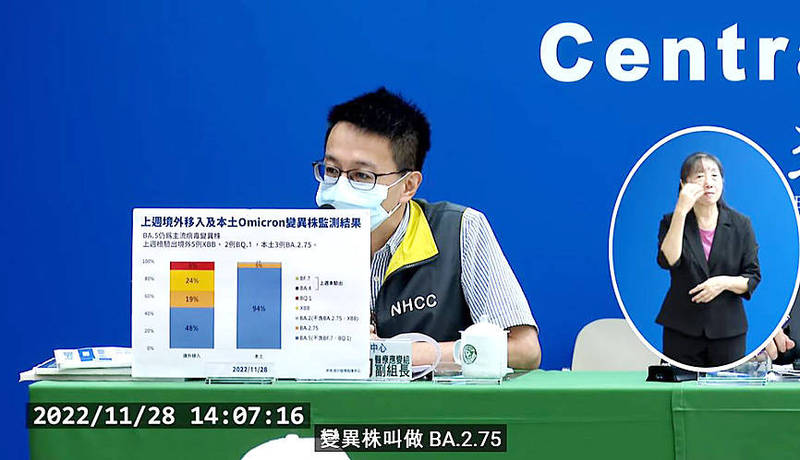《TAIPEI TIMES》 CECC detects nation’s 1st BA.2.75 subvariant cases

Centers for Disease Control Deputy Director-General Philip Lo speaks at a news conference in Taipei yesterday. Photo: Screen grab from CECC livestream
DECLINING CASES: The center confirmed 18.6 percent fewer cases last week than the week before, and said it expects daily cases to fall to fewer than 10,000 next week
By Lee I-chia / Staff reporter
The Central Epidemic Command Center (CECC) has detected the first local cases of the Omicron BA.2.75 subvariant of SARS-CoV-2, it said yesterday, as it forecast that daily caseloads could fall next week.
Genome sequencing showed that three out of 64 local cases tested had the BA.2.75 subvariant, while one had the BA.2 subvariant and 60, or 94 percent, had the BA.5 subvariant, which remains the dominant strain in Taiwan, said Centers for Disease Control (CDC) Deputy Director-General Philip Lo (羅一鈞), who is deputy director of the CECC’s medical response division.
The BA.2.75 cases, the first detected so far in Taiwan, are a woman in her 40s and her two children who live in northern Taiwan, he said.
They have not traveled abroad recently and are reinfection cases, he said.
The BA.2.75 strain has been spreading since July, but only accounts for fewer than 10 percent of new infections worldwide, Lo said, adding that the center is more concerned about other new Omicron subvariants, such as XBB and BQ.1.
Five of 21 imported cases sequenced last week had XBB, while two had BQ.1, he said.
Lo said that the BQ.1 strain accounts for about 23 percent of new infections globally and more than half of the new infections in the US, while the XBB strain is often detected in imported cases, possibly because it is spreading in neighboring Southeast Asian countries.
The five XBB cases were from Malaysia, Thailand and Indonesia, and the BQ.1 cases came from the US and Sweden, he said.
The sequencing showed that imported BA.5 cases fell to 48 percent, while XBB accounted for 24 percent, BA.2.75 accounted for 19 percent and BQ.1 accounted for 9 percent, he said.
The center is monitoring the growth of new subvariants, but is unable to predict which would become dominant, he said.
Deputy Minister of Health and Welfare Victor Wang (王必勝), who heads the center, said that 104,451 new local cases were confirmed last week, which is an 18.6 percent decline from the previous week.
Based on the center’s simulations, it expects daily caseloads to fall to fewer than 10,000, although case numbers would likely still fluctuate day to day, he said.
Wang said it was unlikely that the center would soon shorten its “5+n” policy of five days of mandatory home isolation followed by up to seven days of self-health management for confirmed COVID-19 cases.
The risk of confirmed cases spreading the virus is still high within five days, and many countries still require confirmed cases to isolate for five to seven days, he said.
The CECC reported 10,583 new local cases, 76 imported cases and 41 deaths yesterday.
新聞來源:TAIPEI TIMES















